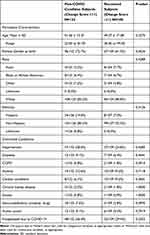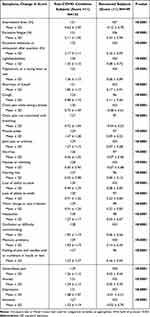Back to Journals » International Journal of General Medicine » Volume 15
A Diagnostic Survey for Screening Patients for Post-Covid Conditions
Authors Jacobs LG , Gourna Paleoudis E
Received 20 April 2022
Accepted for publication 22 June 2022
Published 19 July 2022 Volume 2022:15 Pages 6211—6214
DOI https://doi.org/10.2147/IJGM.S370610
Checked for plagiarism Yes
Review by Single anonymous peer review
Peer reviewer comments 2
Editor who approved publication: Dr Scott Fraser
Laurie G Jacobs,1 Elli Gourna Paleoudis2
1Department of Medicine, Hackensack Meridian School of Medicine, Nutley, NJ, USA; 2Department of Medical Sciences, Hackensack Meridian School of Medicine, Nutley, NJ, USA
Correspondence: Laurie G Jacobs, Hackensack University Medical Center, 30 Prospect Avenue, Hackensack, NJ, 07601, USA, Tel +1 551 996 3500, Fax +1 551 996 3298, Email [email protected]
Introduction
Post-Covid conditions1 may afflict 10–30% of individuals following infection with SARS-CoV-2 and have been defined as symptoms present or persisting ≥3 months after infection, and continue for ≥2 months, without an alternative diagnosis.2 They have been characterized by the array of patient reported symptoms across organ system domains, with fatigue, breathlessness, and confusion commonly described.3 Despite numerous reports, no consensus has been reached regarding the diagnostic symptoms of post-Covid conditions. This cross-sectional study evaluates the use of a standardized symptom survey as a diagnostic screening test for post-Covid conditions.
Materials and Methods
No extramural funding supported this work. This work was done in accord with the Declaration of Helsinki and received Institutional Review Board approval at Hackensack Meridian Health. Participants were anonymously recruited from electronic medical record data of patients who had a positive COVID-19 PCR test between July 1, 2020 and August 30, 2021, and those who were subsequently evaluated for post-Covid conditions at a Covid Recovery Clinic. Patients were evaluated 3–12 months following their infection. In December 2021, using REDCap,4 participants were contacted by email, provided informed consent, completed the survey online.
The survey rated the intensity or impact of 25 common symptoms associated with post-covid conditions which occurred “during the past week” and “prior to COVID infection”, using a 5-point scale (0=not present; 1=mild, does not interfere with daily activities; 2=moderate, sometimes interferes; 3=severe, always interferes; 4=very severe, I am disabled by this symptom). Symptom scores, 0 to 4 for each symptom, produced a composite score (0 to 100) for each time point. A change in the composite score between the two time points was calculated for each participant (potential range −100 to +100).
Receiver operating characteristic (ROC) curve analyses were used to identify an ideal cut point in the change composite scores for grouping the patients into the two groups - those who had been evaluated for post-Covid conditions in the Clinic and those who had not. The ideal cut point from ROC analysis would be used to recategorize the patients into new groups of participants with post-Covid conditions (> cut point) versus those who had recovered from their Covid infection (≤ cut point). A change score of 11 points was identified as the ideal cut point.
Results
Responses were obtained from 19.2% (144/750) of patients who had been evaluated in Clinic for post-Covid conditions, and 6.5% (97/1500) who were not. The ROC curve analysis identified an ideal cut point of 11 for the change in the composite score from pre-infection to the present, as the ideal cut point separating participants who recovered after infection from those who presented with post-COVID conditions. Demographics and comorbid conditions were similar (Table 1), with the greatest change in symptom ratings for post-exertional weakness or exhaustion, excessive fatigue, confusion, memory problems and dyspnea (Table 2).
 |
Table 1 Participant Demographics and Comorbidities |
 |
Table 2 Change in Symptom Scores (Pre-Covid-19 to ≥ 3 Months After Acute Covid-19 Infection) |
For the Clinic participants, 107 of the 144 had a change in symptom score of >11, indicating a sensitivity for this scale and cut point to identify post-COVID condition patients of 74%; 25 of the 97 Positive PCR participants had a score of <11, with a specificity of 74%.
Discussion
Although this study represents a small sample size due to a low response rate, participant demographics and comorbidities were similar in both groups defined by the cut point of 11. The use of a value of change in composite symptom score for this 25-symptom survey accounts for pre-infection symptoms due to other conditions which may confound the diagnosis of post-Covid syndromes. It also quantifies and provides a comparison for the range, severity and functional impact of symptoms, while minimally limiting the number of symptoms considered to 25 for diagnostic purposes.
Conclusion
Given the prevalence of potential patients with post-COVID conditions, a clinical screening test to identify patients for care within specialized clinical programs and screen subjects for clinical trial enrollment, this survey performs well with 74% sensitivity and specificity in identifying participants with post-COVID conditions.
Disclosure
The authors report no conflicts of interest in this work.
References
1. Jacobs LG, Gourna Paleoudis E, Lesky-di bari D, et al. Persistence of symptoms and quality of life at 35 days after hospitalization for COVID-19 infection. PLoS One. 2020;15(12):e0243882. doi:10.1371/journal.pone.0243882
2. World Health Organization. A clinical case definition of post COVID-19 condition by a Delphi consensus 6 October 2021. Available from: https://www.who.int/publications/i/item/WHO-2019-nCoV-Post_COVID-19_condition-Clinical_case_definition-2021.1.
3. Michelen M, Manoharan L, Elkheir N, et al. Characterising long COVID: a living systematic review. BMJ Global Health. 2021;6:e005427. doi:10.1136/bmjgh-2021-005427
4. Harris PA, Taylor R, Thielke R, et al. Research electronic data capture (REDCap) – a metadata-driven methodology and workflow process for providing translational research informatics support. J Biomed Inform. 2009;42(2):377–814. doi:10.1016/j.jbi.2008.08.010
 © 2022 The Author(s). This work is published and licensed by Dove Medical Press Limited. The full terms of this license are available at https://www.dovepress.com/terms.php and incorporate the Creative Commons Attribution - Non Commercial (unported, v3.0) License.
By accessing the work you hereby accept the Terms. Non-commercial uses of the work are permitted without any further permission from Dove Medical Press Limited, provided the work is properly attributed. For permission for commercial use of this work, please see paragraphs 4.2 and 5 of our Terms.
© 2022 The Author(s). This work is published and licensed by Dove Medical Press Limited. The full terms of this license are available at https://www.dovepress.com/terms.php and incorporate the Creative Commons Attribution - Non Commercial (unported, v3.0) License.
By accessing the work you hereby accept the Terms. Non-commercial uses of the work are permitted without any further permission from Dove Medical Press Limited, provided the work is properly attributed. For permission for commercial use of this work, please see paragraphs 4.2 and 5 of our Terms.
